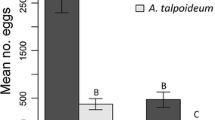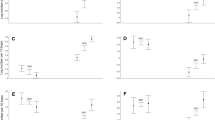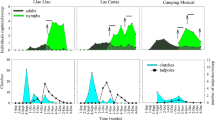Summary
Terrestrial oviposition with free-living aquatic larvae is a common reproductive mode used by amphibians within the central Amazonian rainforest. We investigated the factors presently associated with diversity of microhabitats (waterbodies) that may be maintaining the diversity of reproductive modes. In particular, desiccation, predation by fish, competition with other anurans and water quality were examined in 11 waterbodies as possible forces leading to the evolution of terrestrial oviposition. Predation experiments demonstrated that fish generally do not eat anuran eggs, and that predacious tadpoles and dytiscid beetle larvae are voracious predators of anuran eggs. The percentage of species with terrestrial oviposition was only weakly correlated with the occurrence of pond drying, pH and oxygen concentration, suggesting that anurans in this tropical community are able to use the range of water quality available for egg development. There was a tendency for terrestrial oviposition to be associated with the number of species of tadpoles using the waterbody, but we consider this to be spurious as there was no obvious competitive mechanism that could result in this relationship. The percentage of species with terrestrial oviposition was significantly positively related to our index of egg predation pressure, and negatively related to our index of fish biomass. Egg predation pressure was also negatively related to the index of fish biomass. These results allow us to discount as improbable the hypothesis that predation by fish on anuran eggs was an important selective pressure leading to terrestrial oviposition in this community. The strong positive relationship between terrestrial oviposition and our index of egg predation pressure indicates that these predators have exerted, and are exerting, a significant selective pressure for terrestrial oviposition. The strong negative relationship between the occurrence of fish and the egg predators suggests the surprising conclusion that the presence of fish actually protects aquatic anuran eggs from predation in this tropical system, and allows aquatic oviposition to dominate only in those waterbodies with moderate to high densities of fish. Our results suggest that terrestrial oviposition is a “fixed predator avoidance” trait.
Similar content being viewed by others
References
Alcala AC (1962) Breeding behavior and early development of frogs of Negros, Philippine Islands. Copeia 1962:679–726
Alford RA (1989) Variation in predator phenology affects predator performance and prey community composition. Ecology 70:206–219
Allan JD (1978) Trout predation and the size composition of stream drift. Limnol Oceonogr 23:1231–1237
Baldauf R (1947) Desmognathus f. fuscus eating eggs of its own species. Copeia 1947:66
Bogart JP (1981) How many times has terrestrial breeding evolved in anuran amphibians? Monitore Zool Ital XV:23–28
Brodie ED Jr, Formanowicz DR Jr, Brodie ED III (1978) The development of noxiousness of Bufo americanus tadpoles to aquatic insect predators. Herpetologica 34:302–306
Cargo DG (1960) Predation of eggs of the spotted salamander, Ambystoma maculatum, by the leech, Acrobdella decora. Chesapeake Sci 1:119–120
Coe M (1974) Observations on the ecology and breeding biology of the genus Chiromantis (Amphibia, Rhacophoridae). J Zool Lond 172:13–34
Connell JH (1975) Some mechanisms producing structure in natural communities: a model and evidence from field experiments. In: Cody ML, Diamond JM (eds) Ecology and evolution of communities. Harvard Univ. Press, Cambridge, Mass., pp 460–490
Connell JH (1980) Diversity and the coevolution of competitors, or the ghost of competition past. Oikos 35:131–138
CoryL, MarionJJ (1953) Predation on eggs of the wood frog, Rana sylvatica by leeches. Copeia 1953:66
Crump ML (1974) Reproductive strategies in a tropical anuran community. Univ Kansas Mus Nat Hist Misc Publ 61:1–68
Crump ML (1982) Amphibian reproductive ecology on the community level. In: Scott NJJr (ed) Herpetological communities. Wildl Res Rept No 13, pp 21–36
Crump ML (1983) Opportunistic cannibalism by amphibian larvae in temporary aquatic environments. Am Nat 121:281–287
Dalrymple GH (1970) Caddis fli larvae feeding upon eggs of Ambystoma t. tigrinum. Herpetologica 26:128–129
Downie JR (1988) Functions of the foam in the foam-nesting Leptodactylid Physalaemus pustulosus. Herp J 1:302–307
Duellman WE, Trueb L (1986) Biology of amphibians. McGraw-Hill, New York Dunn ER (1926) The frogs of Jamaica. Proc Boston Soc Nat Hist 38:111–130
DunnER (1937) The amphibian and reptilian fauna of bromeliads in Costa Rica and Panama. Copeia 1937:163–167
Formanowicz DR Jr (1986) Anuran tadpole/aquatic insect predator prey interactions: tadpole size and predator capture success. Herpetologica 42:367–373
Formanowicz DR Jr, Brodie ED Jr (1982) Relative palatabilities of members of a larval amphibian community. Copeia 1982:91–97
Goin CJ (1959) Amphibians, pioneers of terrestrial breeding habits. Annual Smithsonian Report 1959:427–445
Goin OB, Goin CJ (1962) Amphibian eggs and the montane environment. Evolution 16:364–371
Gosner KL (1960) A simplified table for staging anuran embryos and larvae with notes on identification. Herpetologica 16:183–190
Grubb JC (1972) Differential predation by Gambusia affinus on the eggs of seven species of Anuran amphibians. Am Midl Nat 88:102–108
Guillaumet J-L (1987) Some structural and floristic aspects of the forest. Experientia 43:241–251
Hero J-M (1990). An illustrated key to tadpoles occurring in the central Amazon rainforest, Manaus, Amazonas Brasil. Amazoniana 11(2) (in press)
Hero J-M, Galatti U (1990) Characteristics distinguishing Leptodactylus pentadactylus and L. knudseni in Central Amazon rainforest. J Herpetol 24(2):226–228
Heusser H (1970) Laich-Fressen durch Kaulquappen als mogliche Ursache spezifischer Biotoppraferenzen und kurzer Laichzeiten bei europaischen Frochlurchen (Amphibia, Anura). Oecologia 4:83–88
Heusser H (1971) Differenzierendes Kaulquappen-Fressen durch Molche. Experientia 27:475
Heyer WR (1969) The adaptive ecology of the species groups of the genus Leptodactylus (Amphibia, Leptodactylidae). Evolution 23:421–428
Heyer WR (1975) A preliminary analysis of the intergeneric relationships of the frog family Leptodactylidae. Smithson Contrib Zool 199:1–54
Heyer WR, McDiarmid RW, Weigmann DL (1975) Tadpoles, predation and pond habitats in the tropics. Biotropica 7:100–111
Kats LB, Petranka JW, Sih A (1988) Antipredator defenses and the persistence of amphibian larvae with fishes. Ecology 69:1865–1870
Kluge AG (1980) The life history, social organisation, and parental behavior of Hyla rosenbergi Boulenger, a nest-building gladiator frog. Misc Pub Mus Zool Univ Michigan 160:1–170
Laessle AM (1961) A micro-limnological study of Jamaican bromeliads. Ecology 42:499–517
Lee AK (1967) Studies in Australian amphibia. II Taxonomy, ecology and evolution of the genus Helioporus Gray (Anura: Leptodactylidae). Aust J Zool 15:367–439
Licht LE (1968) Unpalatability and toxicity of toad eggs. Herpetologica 24:93–98
Licht LE (1969) Palatability of Rana and Hyla eggs. Am Midl Nat 82:296–299
Lutz B (1948) Ontogenetic evolution in frogs. Evolution 2:29–39
Lynch JD (1973) The transition from archaic to advanced frogs. In: Vial JL (ed) Evolutionary biology of the anurans. Contemporary research on major problems. University of Missouri Press, Columbia, Missouri, pp 133–182
Macan TT (1974) Freshwater ecology. London, Longmans
Marques Filho AM, Nazare Goes Ribeiro, Menezes dos Santos H, Marden dos Santos J (1981) Estudos climatologicos da Reserva Floresta Ducke- Manaus-.Amazonas. IV Precipitacao. Acta Amazonica 11:759–768
Martin AA (1967) Australian life histories: Some evolutionary and ecological aspects. In: Weatherly AH (ed) Australian inland waters and their fauna. Canberra Nat. Univ. Press, Canberra, pp 175–191
Martin TE (1988) Processes organizing open-nesting bird assemblages: competition or nest predation? Evol. Ecol. 2:37–50
McDiarmid RW (1978) Evolution of parental care in frogs. In: Burghardt G, Bekoff M (eds) The development of behavior. Garland, New York, pp 127–147
McPeek MA (1990) Determination of species composition in the Enallagma Damselfly assemblages of permanent lakes. Ecology 71:83–98
Morin PJ (1983) Predation, competition, and the composition of larval anuran guilds. Ecol Monogr 53:119–138
Morin PJ (1986) Interactions between intraspecific competition and predation in an amphibian predator-prey system. Ecology 67:713–720
Morin PJ (1987) Predation, breeding asynchrony, and the outcome of competition among treefrog tadpoles. Ecology 68:675–683
Noble BG (1927) The value of life history data in the study of the evolution of the amphibian. Ann NY Acad Sci 30:31–128
Paine RT (1966) Food web complexity and species diversity. Am Nat 100:65–75
Petranka JW (1983) Fish predation: a factor affecting the distribution of a stream-breeding salamander. Copeia 1983:624–628
Polis GA, Myers CA (1985) A survey of intraspecific predation among reptiles and amphibians. J Herpetol 19:99–107
Poynton JC (1964) Relationships between habitat and terrestrial breeding in amphibians. Evolution 18:131
Pritchard G (1965) Prey capture by dragonfly larvae (Odonata; Anisoptera). Can J Zool 43:271–289
Savage RM (1961) The ecology and life history of the common frog (Rana temporaria temporaria). Pitman and Sons, London
Scott NJ, Limerick S (1983) Reptiles and amphibians, In: Janzen DH (ed) Costa Rican natural history. Univ Chicago Press, Chicago, pp 351–367
Seale DB (1980) Physical factors influencing oviposition by the wood frog Rana sylvatica in Pennsylvania. Copeia 1982:627–635
Semlitsch RD (1987) Interactions between fish and salamander larvae. Costs of predator avoidance or competition. Oecologia 72:481–486
Sih A (1986) Antipredator responses and the perception of danger by mosquito larvae. Ecology 67:434–441
Sih A (1987) Predator and prey lifestyles: an evolutionary and ecological overview. In: Kerfoot WC, Sih A (eds) Predation: direct and indirect effects on aquatic communities. Univ. Press of New England, Hanover, NH, pp 203–224
Sih A, Crowley P, McPeek M, Petranka J, Strohmeier K (1985) Predation, competition, and prey communities: a review of field experiments. Ann Rev Ecol Syst 16:269–311
Taylor EH (1954) Frog-eating tadpoles of Anotheca coronata (Steineger) (Salienta, Hylidae). Univ Kansas Sci Bull 36:589–596
Tihen JA (1960) Comments on the origin of the amniote egg. Evolution 14:528–531
Waldman B (1982) Sibling association among schooling toad tadpoles: field evidence and implications. Anim Behav 30:700–713
Walters B (1975) Studies of interspecific predation within an amphibian community. J Herpetdl 9:267–279
Werschkul DF, Christensen MT (1977) Differential predation by Lepomis machrochirus on the eggs and tadpoles of Rana. Herpetologica 33:237–241
Wilbur HM (1980) Complex life cycles. Ann Rev Ecol Syst 11:67–93
Wilbur HM (1987) Regulation of structure in complex systems: experimental temporary pond communities. Ecology 68:1437–1452
Wilkinson L (1986) SYSTAT: The system for statistics. SYSTAT Inc., Evanston IL
Author information
Authors and Affiliations
Rights and permissions
About this article
Cite this article
Magnusson, W.E., Hero, JM. Predation and the evolution of complex oviposition behaviour in Amazon rainforest frogs. Oecologia 86, 310–318 (1991). https://doi.org/10.1007/BF00317595
Received:
Accepted:
Issue Date:
DOI: https://doi.org/10.1007/BF00317595




